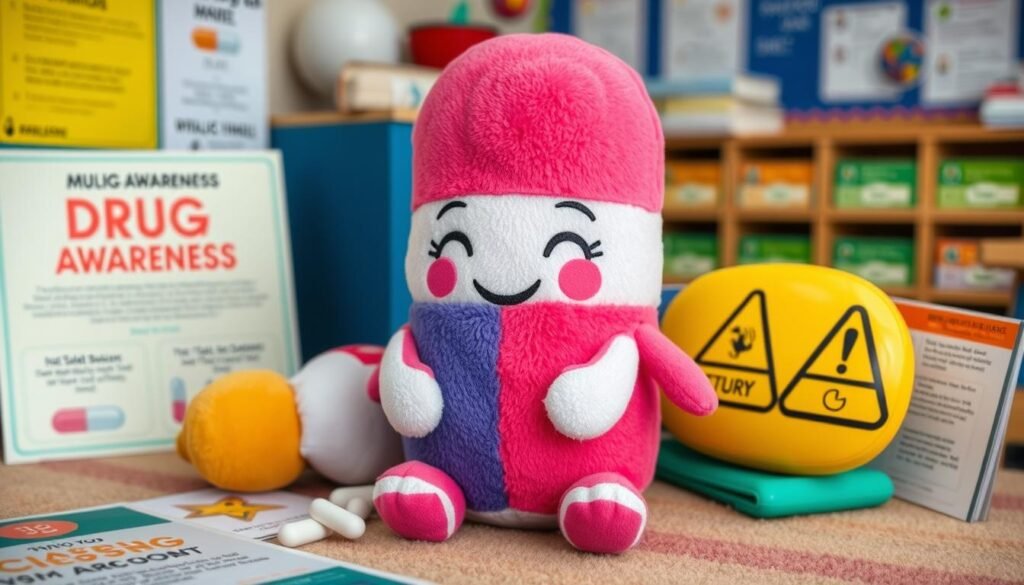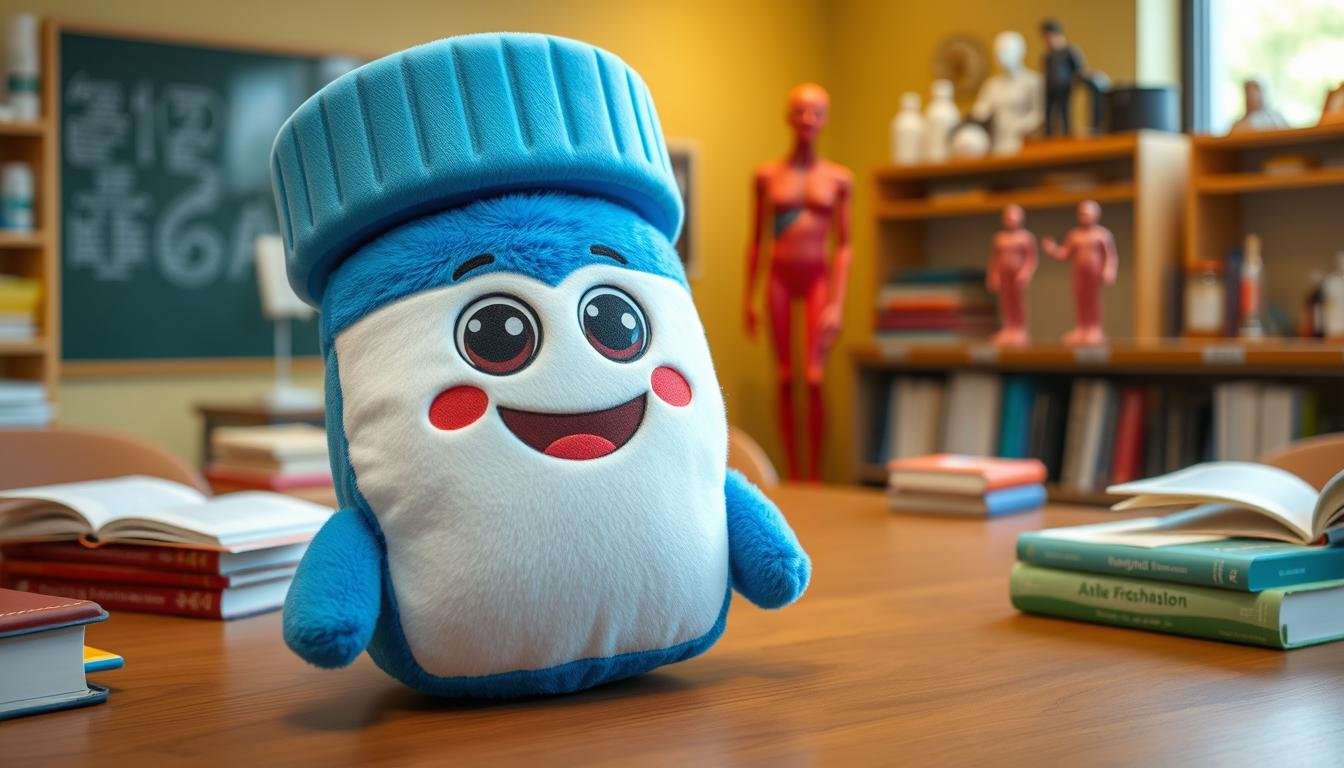Healthcare professionals face a big challenge with the opioid crisis. Education is key to solving this problem. A new tool, the OxyContin stuffed toy, has caught our eye. It aims to teach about addiction and safe use of drugs in medical settings.
The OxyContin stuffed toy helps start conversations about drug abuse. It uses a soft toy to make talking about tough topics easier. This way, we can build empathy and understand the opioid crisis better. Learn more about OxyContin’s history and how it can help us teach others.
Key Takeaways
- The OxyContin stuffed toy is an innovative approach to addressing the opioid crisis through medical education and awareness.
- This plush toy serves as a tangible tool for healthcare providers, educators, and patients to engage in open dialogues about prescription drug abuse and addiction.
- The OxyContin stuffed toy helps foster empathy, understanding, and a deeper appreciation for the complexities surrounding the opioid epidemic.
- By utilizing this educational resource, we can better understand the history and evolution of OxyContin, which can inform our approach to responsible prescription practices.
- Integrating the OxyContin stuffed toy into medical education and patient engagement strategies can contribute to more effective strategies for addressing the opioid crisis.
The OxyContin stuffed toy is a creative way to tackle the opioid crisis. It encourages open talks, better understanding, and helps fight drug abuse and addiction. The insights and data it provides are essential for our ongoing efforts1.
The Controversial Marketing of OxyContin
Purdue Pharma faced a lot of criticism for its bold marketing of OxyContin. They used a big sales team to push doctors, including primary care doctors, to prescribe OxyContin for many types of pain2. This led to a big jump in OxyContin use, especially for noncancer pain, with many doctors prescribing it by 20032.
Purdue’s Aggressive Marketing Strategies
The DEA worried that Purdue’s marketing pushed OxyContin too widely to doctors not well-trained in pain management2. The FDA also took action against Purdue for breaking rules in their ads2. Purdue didn’t review a promotional video for OxyContin with the FDA in 1998, as they should have2.
Purdue’s marketing was very controversial, adding to the opioid crisis in the US2. Purdue doubled its sales team and gave out free OxyContin coupons, causing a huge rise in prescriptions in the US2. By 2002, 5,000 Americans died from prescription opioids yearly, a number that tripled in the next decade2. In 2011, more people died from prescription opioids than from heroin and cocaine together2.
Purdue’s marketing had big effects, with opioid prescriptions in the US going up four times since 19992. This led to more opioid overdoses, even though pain reports didn’t change2. In 2012, opioid sales in the US hit $11 billion, causing 15,000 fatal overdoses because of weak rules2. Today, 142 people die from opioids daily in the US, with 91 of those from opioids2. In 2015, over 52,000 drug overdose deaths were recorded in the US, more than car crashes and gun incidents2.
Purdue Pharma’s aggressive marketing and the opioid crisis led to many lawsuits and more watchful eyes on the prescription drug industry3. As Purdue faced the consequences, other companies started pushing opioids more, targeting doctors Purdue once went after3. This change happened even though the opioid crisis is still severe in many places, showing the need for better rules and checks on the industry3.
| Metric | Data |
|---|---|
| Purdue Pharma’s spending on food and beverage to promote OxyContin | Reduced from $1.5 million in 2014-2015 to $54,000 in 2016-2017, a 94% decrease3. |
| Competing pharmaceutical companies’ spending increase to promote opioids | 160% increase from 2016 to 20173. |
| Prescribers targeted by Purdue Pharma and competitors | Over 600,000 prescribers analyzed in the Open Payments database3. |
| Influence of opioid overdose rates on competitor spending | Increase in competitor spending was not influenced by the severity of opioid overdose rates in prescribers’ counties3. |
| Influence of prescription opioid overdose percentage | Increase in competitor spending was not influenced by the percentage of opioid overdose deaths due to prescription opioids3. |
“Local governments across the US have filed numerous opioid-related lawsuits, leading several firms like Purdue Pharma to file for bankruptcy as a response, signaling a significant impact on the prescription opioid industry.”3
Purdue Pharma’s marketing of OxyContin has had terrible effects, fueling the opioid crisis in the US. Their push to get doctors to prescribe OxyContin for many pains, without enough checks, led to a huge rise in opioid use and deaths. Now, the industry is facing big changes, with a push for stricter rules and better marketing practices.
oxycontin stuffed toy: An Unorthodox Approach to Addiction Awareness
Some groups have made an unusual move to fight the opioid crisis. They created an OxyContin stuffed toy4. This toy aims to start talks about the dangers of addiction and the importance of safe drug use4.
Using a plush toy to talk about serious issues might seem odd. But, its makers believe it’s a way to grab people’s attention. They hope it will help doctors and the public understand the opioid problem better4.
The toy has caused a lot of different reactions. Some people think it’s a clever way to talk about addiction. Others worry it might make the issue seem too light5. Still, the OxyContin stuffed toy has brought attention to the opioid crisis. It’s helped start important talks about how to handle it5.

The opioid crisis is a big problem in the U.S. The OxyContin stuffed toy is a unique way to try and make people aware of it4. Even though it’s sparked debate, it might help in the fight against opioids45.
Conclusion
The growth of OxyContin prescriptions was partly due to Purdue Pharma’s aggressive marketing. This marketing might have hidden the risks of addiction6. Now, some groups are using an OxyContin stuffed toy to teach people about drug abuse.
Using a plush toy to talk about a serious issue might seem odd. But it’s a way to grab attention and start important conversations. Space-themed toys can also inspire kids to learn about science and technology. The OxyContin toy can do the same for drug abuse awareness.
We need to keep finding new ways to tackle the problem of prescription drug misuse. By teaching, advocating, and using creative ideas, we can make a difference. This way, we can ensure our communities stay healthy and safe78.
FAQ
What is the OxyContin stuffed toy?
Why was the OxyContin stuffed toy created?
How did Purdue Pharma market OxyContin?
Has the FDA taken any action against Purdue Pharma for their marketing of OxyContin?
Source Links
- GAO-04-110 Prescription Drugs: OxyContin Abuse and Diversion and Efforts to Address the Problem – https://www.gao.gov/assets/gao-04-110.pdf
- America’s opioid crisis: how prescription drugs sparked a national trauma – https://www.theguardian.com/us-news/2017/oct/25/americas-opioid-crisis-how-prescription-drugs-sparked-a-national-trauma
- Prescription opioid companies increased marketing after Purdue Pharma lawsuit, UW study shows – https://www.washington.edu/news/2023/10/09/prescription-opioid-companies-increased-marketing-after-purdue-pharma-lawsuit-uw-study-shows/
- The New Face of Heroin – https://www.rollingstone.com/culture/culture-news/the-new-face-of-heroin-107942/
- BULLETIN ON NARCOTICS – Volume LXII, 2019 – https://www.unodc.org/documents/data-and-analysis/bulletin/2019/19-11671_ebook.pdf
- AJPH068569_131714 205..227 – https://stopcorruption.moph.go.th/application/editors/userfiles/files/บทความ The Promotion and Marketing of OxyContin.pdf
- On what basis did Health Canada approve OxyContin in 1996? A retrospective analysis of regulatory data – https://www.ncbi.nlm.nih.gov/pmc/articles/PMC9523806/
- What’s Fact and What’s Fiction in Painkiller, Netflix’s Hit Show About the Opioid Crisis – https://slate.com/culture/2023/08/painkiller-netflix-true-story-purdue-oxycontin-richard-sackler.html

